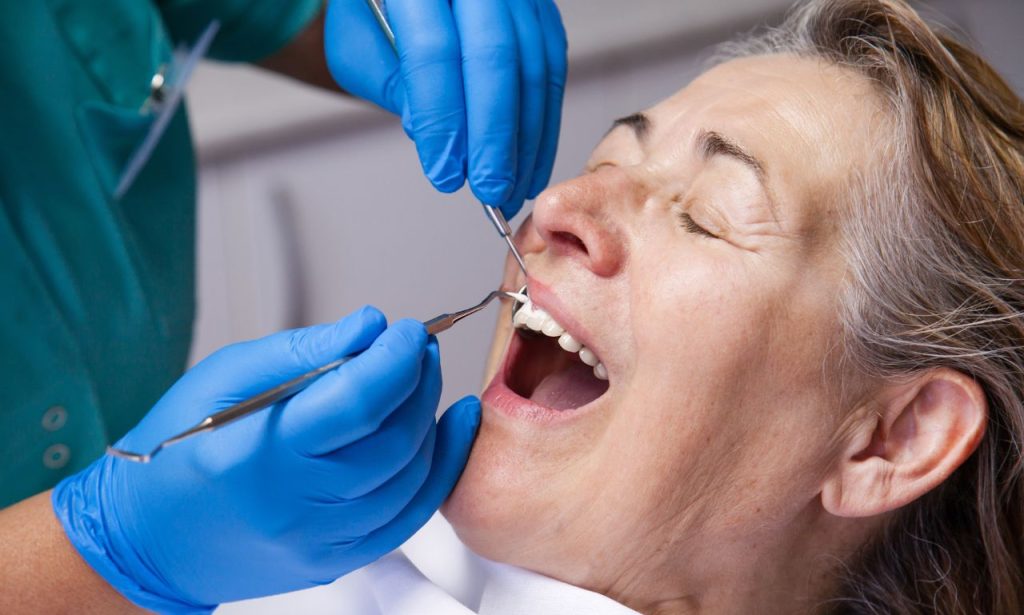Periodontal disease, also known as gum disease, is a serious oral health issue that affects nearly half of American adults. Left untreated, it can lead to tooth loss and other health complications. But what exactly is periodontal disease, and how does it progress? In this article, we’ll dive into the five stages of periodontal disease, exploring the signs, symptoms, and treatment options at each stage.
What is Periodontal Disease?

Periodontal disease is an infection of the gums and supporting structures of the teeth. It is primarily caused by the buildup of plaque, a sticky film of bacteria, on the teeth and gums. When plaque is not removed effectively through proper oral hygiene practices such as brushing and flossing, it hardens into tartar, harboring harmful bacteria. These bacteria produce toxins that irritate and inflame the gum tissue, leading to the development of gum disease.
Periodontal disease can be divided into two main types:
- Gingivitis: This is the earliest and mildest form of gum disease. Gingivitis is characterized by gum inflammation, redness, and bleeding. It is typically reversible with improved oral hygiene and professional dental cleanings.
- Periodontitis: If gingivitis is not treated, it progresses to periodontitis, a more severe form of gum disease. During periodontitis, the inflammation extends to the supporting bone structure of the teeth, leading to tissue and bone loss, and eventually causing the teeth to become loose.
Periodontal disease is not just a dental issue; it can also impact overall health. Studies have linked untreated periodontal disease to systemic conditions like cardiovascular disease, diabetes, and respiratory infections. Understanding the different stages of periodontal disease can help prevent its progression and minimize risks to both oral and general health.
The 5 Stages of Periodontal Disease
Periodontal disease progresses through five distinct stages, each with its own set of symptoms and treatment options. Here’s a closer look at each stage:
Stage 1: Gingivitis

Gingivitis is the earliest stage of periodontal disease and is often marked by mild inflammation of the gums. It occurs when plaque buildup irritates the gum tissue, causing swelling and tenderness. Common symptoms of gingivitis include:
- Red, swollen gums
- Gums that bleed easily when brushing or flossing
- Bad breath or a persistent bad taste in the mouth
- Tender gums
One of the significant aspects of gingivitis is that it is reversible. With an effective oral hygiene routine, including brushing twice daily, daily flossing, and regular visits to the dentist for professional cleaning, it is possible to reverse the symptoms. Neglecting this early-stage gum disease can lead to progression, making it more challenging to treat.
To prevent gingivitis from advancing, it is essential to maintain a good oral hygiene routine that includes:
- Brushing twice daily with fluoride toothpaste
- Daily flossing to remove plaque and food particles from between teeth
- Using an antimicrobial mouthwash to reduce bacteria in the mouth
- Regular dental cleanings to remove tartar buildup and maintain gum health
Stage 2: Slight Periodontal Disease
If gingivitis is not treated, it can progress to slight periodontal disease, the second stage of gum disease. During this stage, the inflammation has extended beyond the gum line, causing the gums to pull away from the teeth and forming periodontal pockets. These pockets trap food particles and harmful bacteria, making it more challenging to maintain oral health.
Symptoms of slight periodontal disease include:
- Gums that bleed easily during brushing or flossing
- Persistent bad breath
- Gum recession as the gum tissue begins to pull away from the teeth
- Tooth sensitivity to hot or cold temperatures
- Mild bone loss
The primary treatment for slight periodontal disease is a deep cleaning procedure known as scaling and root planing. During this procedure, a dental professional will remove plaque and tartar buildup from above and below the gum line and smooth out the root surfaces to help the gums reattach to the teeth. In some cases, antiseptic mouthwash or topical antibiotics may be prescribed to help manage bacterial infection.
Stage 3: Moderate Periodontal Disease
Moderate periodontal disease is the third stage of gum disease and is characterized by a deeper level of infection and damage. The periodontal pockets formed during slight periodontitis become deeper, allowing for the accumulation of more bacteria and toxins. At this point, the infection has spread to the soft tissues and supporting bone structure of the teeth.
Symptoms of moderate periodontal disease include:
- Gums that bleed easily
- Persistent bad breath
- More pronounced gum recession
- Tooth mobility or loose teeth
- Pain when chewing
- Increased pocket depths
Treatment for moderate periodontal disease often requires scaling and root planing to remove bacterial plaque and tartar from the pockets. Oral antibiotics or topical antibiotics may be used to control the infection. In some cases, surgical intervention may be required to remove infected tissue and reshape the supporting bone to help stabilize the teeth.
It is crucial to manage moderate periodontal disease effectively to prevent further damage and tooth loss. Consistent dental visits, adherence to oral hygiene practices, and the use of antibacterial mouthwash are essential to keep the condition under control.
Stage 4: Advanced Periodontal Disease
Advanced periodontal disease, also known as severe periodontitis, is the most severe form of gum disease. At this stage, the infection has caused significant damage to the gum tissue, bone, and the connective tissues that hold the teeth in place. The deepening of periodontal pockets and the continued destruction of the bone tissue lead to the potential for tooth loss.
Symptoms of advanced periodontal disease include:
- Gums that bleed easily
- Severe gum recession, exposing the tooth roots
- Persistent bad breath
- Loose teeth or teeth that shift out of place
- Severe pain when chewing
- Pus between the teeth and gums, indicating infection
- Changes in bite or tooth alignment
Advanced periodontal disease often requires a combination of treatments, including:
- Scaling and root planing to remove deep bacterial pockets
- Flap surgery: The gums are lifted back to remove tartar and smooth damaged bone surfaces.
- Bone grafts: This involves using fragments of bone to replace bone lost due to the disease. This helps stabilize the teeth and encourages new bone growth.
- Tissue regeneration: A special membrane is placed between the gum and bone to encourage the regrowth of bone and gum tissue.
- Tooth extraction: In some cases, teeth that are severely damaged by periodontal disease may need to be removed and replaced with dental implants or bridges.
Advanced periodontal disease requires extensive treatment and close monitoring to manage the condition effectively. Regular dental visits and proper oral hygiene practices are crucial to prevent further damage and maintain oral health.
Stage 5: Refractory Periodontal Disease

Refractory periodontal disease is a form of advanced periodontitis that does not respond to traditional treatments. This may be due to factors such as a genetic predisposition, certain medical conditions (such as diabetes or HIV/AIDS), or lifestyle factors like smoking. Patients with refractory periodontitis may experience ongoing bone and tissue loss despite receiving proper periodontal treatment.
Symptoms of refractory periodontal disease can include:
- Persistent gum inflammation and swelling
- Loose teeth
- Deep gum pockets that do not respond to deep cleaning procedures
- Ongoing bone loss
Treating refractory periodontal disease often involves more aggressive measures, such as:
- Pocket reduction surgery: The gums are lifted back to remove tartar and diseased tissue, and then sutured to reduce pocket depth.
- Laser therapy: A laser is used to remove diseased gum tissue and tartar buildup, promoting healing and reducing inflammation.
- Antimicrobial therapy: Antibiotics or other antimicrobial medications may be used to control the bacterial infection.
Patients with refractory periodontal disease should work closely with a periodontal specialist to manage their condition and maintain their remaining teeth. Lifestyle changes, such as quitting smoking and controlling underlying health conditions, can also help improve treatment outcomes.
Comparing the Stages of Periodontal Disease
| Stage | Symptoms | Treatment |
|---|---|---|
| 1: Gingivitis | Red, swollen gums; bleeding when brushing/flossing; bad breath | Improved oral hygiene; regular dental cleanings |
| 2: Slight Periodontal Disease | Gum recession; sensitive teeth; persistent bad breath | Scaling and root planing |
| 3: Moderate Periodontal Disease | Loose teeth; pain when chewing | Scaling and root planing; antibiotics; surgical interventions |
| 4: Advanced Periodontal Disease | Pus between teeth and gums; change in bite or tooth alignment | Flap surgery; bone grafts; tissue regeneration; tooth extraction |
| 5: Refractory Periodontal Disease | Unresponsive to traditional treatments | Pocket reduction surgery; laser therapy; antimicrobial therapy |
Risk Factors for Periodontal Disease
Several risk factors can increase an individual’s likelihood of developing periodontal disease. These include:
- Poor oral hygiene habits: Inadequate brushing and flossing allow plaque to accumulate on the teeth, leading to gum inflammation.
- Smoking and tobacco use: Tobacco products are a significant risk factor for the development of gum disease and can also make treatment less effective.
- Medical conditions: Conditions like diabetes, cardiovascular disease, and immune system disorders can increase the risk of gum disease.
- Family history: Genetics can play a role in an individual’s susceptibility to gum disease.
- Hormonal changes: Hormonal fluctuations during pregnancy, menopause, or puberty can make gums more sensitive and increase the risk of gum inflammation.
- Medications: Certain medications that cause dry mouth can reduce saliva production, making it harder to wash away plaque and bacteria.
- Poor nutrition: A diet high in sugary foods and lacking essential nutrients can contribute to poor oral health and increase the risk of gum disease.
Preventing Periodontal Disease
The best way to prevent periodontal disease is to maintain good oral hygiene and make regular visits to the dentist. Here are some preventive measures to keep your gums healthy:
- Brush and Floss Regularly: Brush your teeth at least twice a day and floss daily to remove plaque and prevent gum disease.
- Use Mouthwash: Use an antimicrobial or fluoride mouthwash to help reduce bacteria in the mouth and strengthen teeth.
- Visit the Dentist Regularly: Schedule regular dental cleanings and check-ups to catch early signs of gum disease and maintain oral health.
- Maintain a Healthy Diet: Eat a balanced diet rich in vitamins and minerals to promote healthy gums and teeth. Avoid excessive consumption of sugary and sticky foods.
- Quit Smoking: Smoking is a significant risk factor for gum disease, so quitting can significantly reduce your risk.
- Manage Health Conditions: If you have underlying health conditions like diabetes, work with your healthcare provider to manage them effectively.
The Link Between Periodontal Disease and Overall Health
Periodontal disease is not only a dental issue; it can have serious implications for overall health. Chronic inflammation caused by gum disease has been linked to a variety of health conditions, including:
- Heart disease: Inflammation from periodontal disease may contribute to the buildup of arterial plaque, increasing the risk of heart attack and stroke.
- Diabetes: People with diabetes are at a higher risk of developing periodontal disease, and gum disease can make it harder to control blood sugar levels.
- Respiratory infections: Bacteria from periodontal pockets can be inhaled into the lungs, potentially leading to respiratory infections like pneumonia.
- Pregnancy complications: Gum disease has been linked to premature birth and low birth weight in infants.
Conclusion
Periodontal disease is a serious oral health issue that can have significant consequences if left untreated. By understanding the five stages of periodontal disease and the signs and symptoms to watch for, you can take steps to protect your gums and preserve your oral health. If you suspect you may have periodontal disease, don’t hesitate to schedule an appointment with your dentist or periodontist for an evaluation and personalized treatment plan.
ALSO READ: How to Start a Red Light Therapy Business
FAQs
Gingivitis, the earliest stage of periodontal disease, can be reversed with proper oral hygiene and regular dental cleanings. However, more advanced stages of periodontal disease may require more extensive treatments to manage the infection and prevent further damage.
The best way to prevent periodontal disease is to practice good oral hygiene, including brushing twice a day, flossing daily, and using an antimicrobial mouthwash. Regular dental check-ups and cleanings are also important for removing plaque and tartar buildup and catching any signs of gum disease early.
Yes, research has shown that periodontal disease is associated with an increased risk of several systemic health problems, including heart disease, diabetes, and respiratory infections. This is thought to be due to the chronic inflammation caused by the bacterial infection in the gums.
If you have been diagnosed with periodontal disease, your dentist may recommend more frequent check-ups and cleanings to monitor your condition and prevent further damage. This may involve visits every 3-4 months, depending on the severity of your case.
In most cases, periodontal disease must be treated and managed before dental implants can be placed. This is because the success of dental implants depends on having healthy gums and adequate bone support. Your dentist or periodontist can assess your individual case and determine the best course of treatment.



